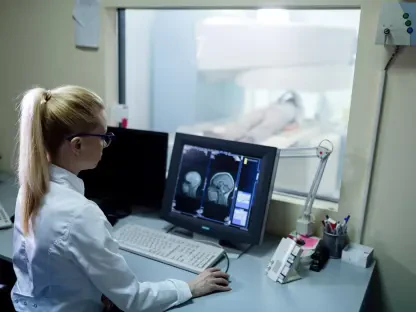Imagine a world where a simple voice recording could reveal a life-threatening condition like laryngeal cancer before any physical symptoms become apparent, transforming the landscape of early medical diagnostics. This is not a distant dream but a reality being shaped by cutting-edge artificial intelligence technology. With over 1 million people globally affected by laryngeal cancer, early detection remains a critical challenge in improving survival rates. AI-driven voice analysis offers a non-invasive solution, potentially revolutionizing how medical diagnostics approach this devastating disease by identifying subtle vocal changes linked to cancer.
Unveiling the Power of Vocal Biomarkers
At the heart of this technology lies the concept of vocal biomarkers—specific characteristics in a person’s speech that can signal the presence of laryngeal cancer. By analyzing voice recordings, AI systems detect anomalies in the larynx, the voice box responsible for sound production. These systems focus on minute differences in speech patterns that are imperceptible to the human ear, providing a groundbreaking method for non-invasive diagnosis.
The significance of this approach cannot be overstated. Traditional diagnostic methods often involve invasive procedures like biopsies or imaging scans, which can be costly and inaccessible for many. AI voice analysis, on the other hand, promises a simpler, more scalable solution that could democratize access to early cancer detection, especially in underserved regions.
Technical Features of AI Voice Analysis
Harmonic-to-Noise Ratio: A Key Diagnostic Tool
One of the primary features of this technology is its use of the harmonic-to-noise ratio, a metric that evaluates the clarity of speech against background noise. In patients with laryngeal cancer, lesions on the vocal folds often disrupt this balance, creating detectable irregularities. AI algorithms excel at identifying these disruptions, particularly in male patients, where the technology has shown remarkable accuracy.
This focus on speech clarity provides a reliable indicator for distinguishing between healthy individuals and those with potential cancerous growths. The precision of AI in measuring such subtle variations underscores its potential as a diagnostic tool, paving the way for earlier interventions that could save lives.
Pitch Variations: Detecting Vocal Fold Anomalies
Another critical feature is the analysis of pitch variations, which often change due to the presence of lesions on the vocal folds. These alterations in pitch, though minor, are significant markers of laryngeal cancer and can be captured through sophisticated AI models. The technology’s ability to pinpoint these changes offers a window into the disease’s progression at its earliest stages.
The technical challenge lies in training AI systems to recognize these variations across diverse vocal profiles. Despite this complexity, the capacity to detect pitch anomalies represents a vital step toward refining the accuracy of voice-based diagnostics, ensuring that even slight deviations are not overlooked.
Performance and Real-World Impact
The performance of AI in voice-based cancer detection has been demonstrated through extensive research, analyzing thousands of voice recordings to identify patterns linked to laryngeal cancer. Notably, the technology has shown strong results in male patients, with distinct vocal biomarkers providing clear diagnostic signals. This success highlights AI’s potential to integrate into routine health screenings or telemedicine platforms for broader reach.
Beyond performance metrics, the real-world impact is profound. Early detection of laryngeal cancer drastically improves survival odds, with a five-year survival rate of 78% for early-stage cases compared to just 35% for late-stage diagnoses. By enabling quicker identification, this technology could significantly reduce mortality rates associated with the disease.
Moreover, the non-invasive nature of voice analysis makes it an ideal candidate for widespread adoption. Patients could potentially record their voices using everyday devices like smartphones, allowing for remote assessments and reducing the burden on healthcare facilities. This accessibility could be a game-changer in global health initiatives.
Current Limitations and Challenges
Despite its promise, the technology faces notable limitations, particularly in its inability to effectively detect vocal differences in female patients with laryngeal cancer. This gender disparity points to a critical gap in current datasets, which lack sufficient diversity to ensure equitable performance across all demographics. Addressing this issue requires expanded data collection efforts.
Additional challenges include the scarcity of professionally labeled voice recordings for training AI models. Without comprehensive datasets, the risk of bias in diagnostic outcomes remains a concern. Overcoming this hurdle is essential to achieving consistent and reliable results in varied populations.
Regulatory and clinical validation also pose significant obstacles. Integrating AI voice analysis into medical practice demands rigorous testing to meet stringent standards for diagnostic tools. These steps are crucial to gaining trust from healthcare providers and ensuring patient safety in real-world applications.
Looking Ahead: Future Developments
The future of AI voice cancer detection appears promising, with ongoing efforts to enhance algorithms and broaden datasets. Researchers anticipate that within the next few years, from now until 2027, clinical pilots could test the technology’s effectiveness in diverse settings. Such trials will be pivotal in validating its diagnostic capabilities on a larger scale.
Expanding the scope of this technology to include other vocal disorders or cancers is another exciting prospect. As AI models become more sophisticated, their application could extend beyond laryngeal cancer, offering a versatile tool for various medical diagnostics. This adaptability could redefine non-invasive health assessments.
Ultimately, the long-term vision involves making voice-based diagnostics a standard component of healthcare. With continued investment in research and development, this technology has the potential to improve global health outcomes by ensuring early detection becomes accessible to all, regardless of geographic or economic barriers.
Final Thoughts and Next Steps
Reflecting on the journey of AI voice cancer detection, it becomes evident that this technology marks a significant milestone in medical diagnostics, especially for male patients where its accuracy shines. The ability to identify laryngeal cancer through vocal biomarkers like harmonic-to-noise ratio and pitch variations offers a glimpse into a future of non-invasive health solutions. Yet, the gap in detecting the disease among female patients underscores a pressing need for improvement.
Moving forward, the focus shifts to actionable steps such as gathering more diverse voice data to address gender disparities. Collaborative efforts between researchers, healthcare providers, and tech developers are deemed essential to refine AI models and push for clinical validation. These initiatives promise to bridge existing gaps and solidify the technology’s role in routine medical practice.
Lastly, advocacy for integrating this tool into public health systems emerges as a vital consideration. Stakeholders need to prioritize funding and policy support to ensure that voice-based diagnostics reach underserved communities. This commitment to accessibility holds the key to transforming early cancer detection on a global scale, ultimately saving countless lives.









